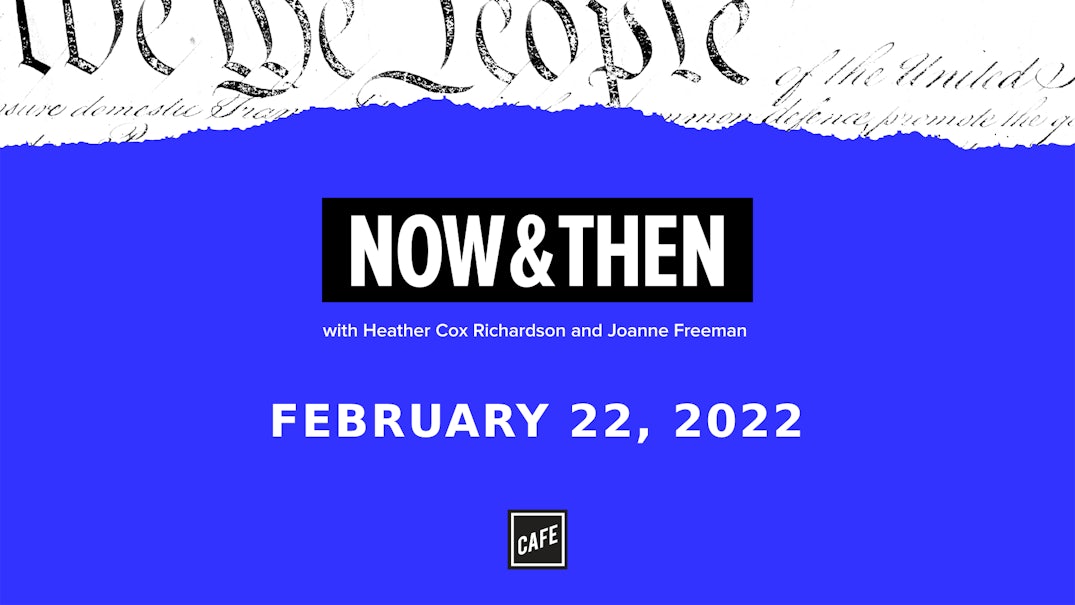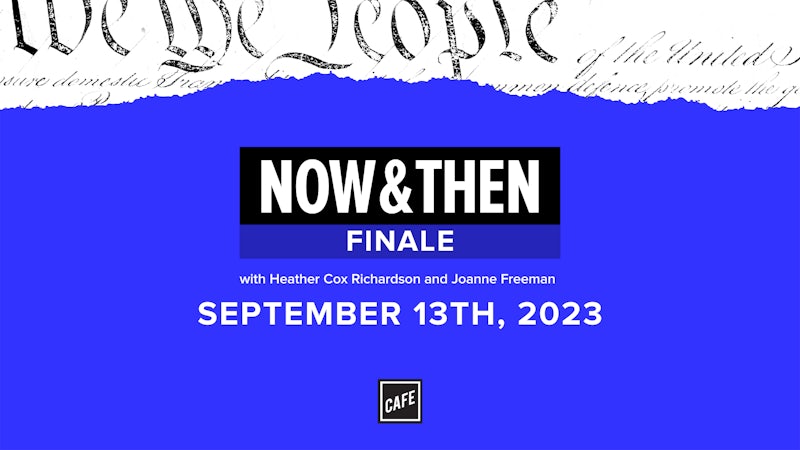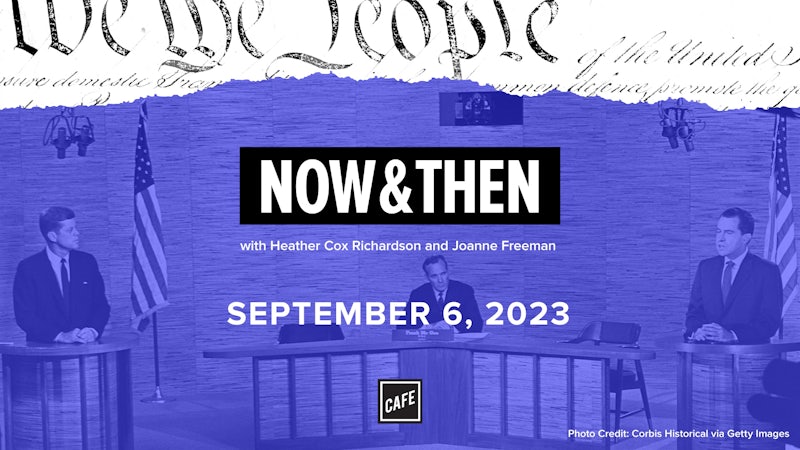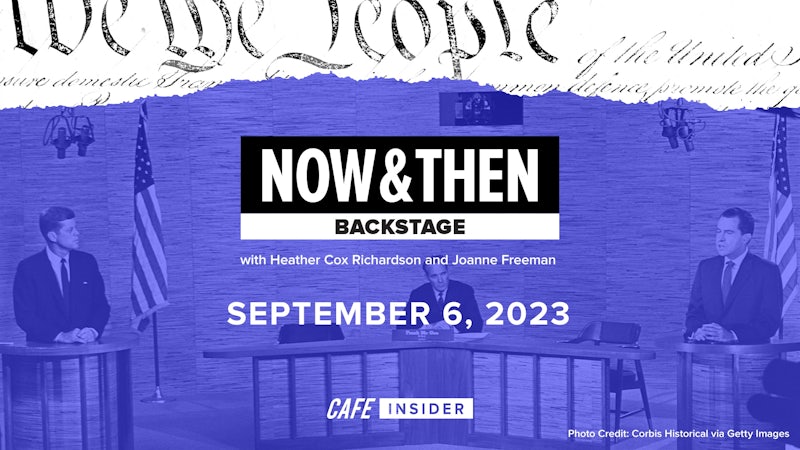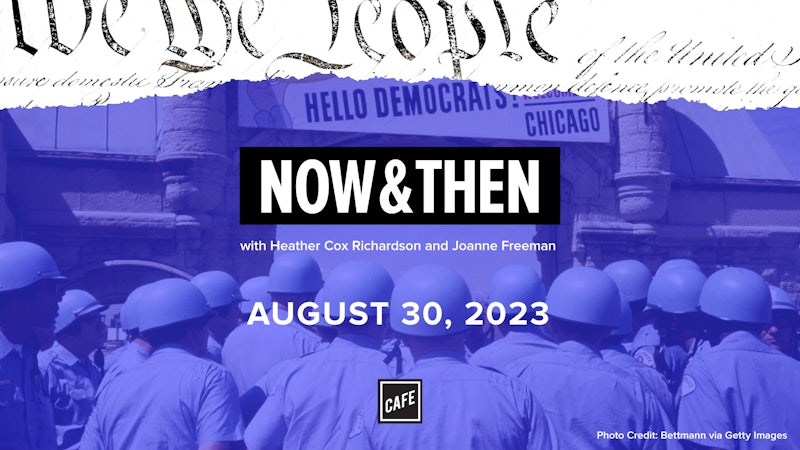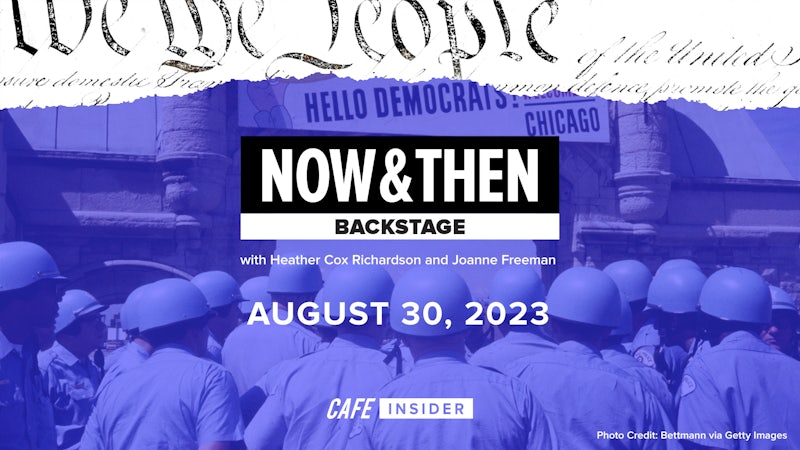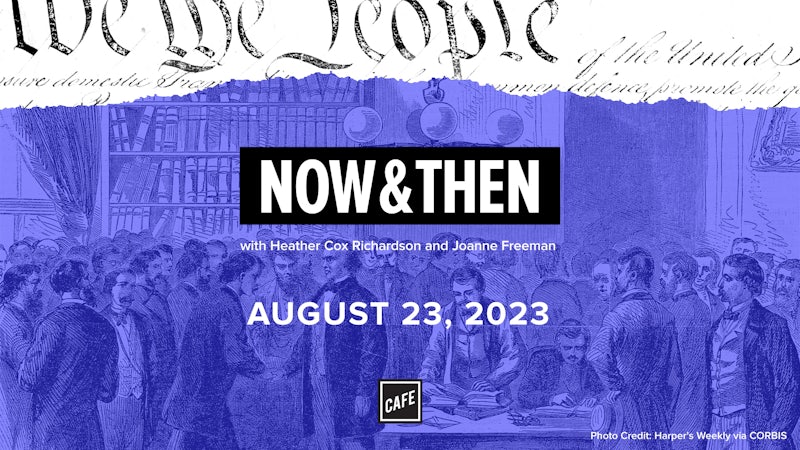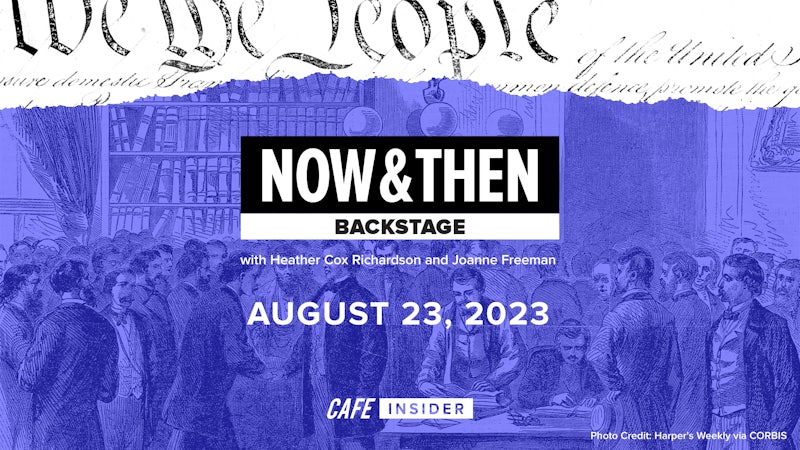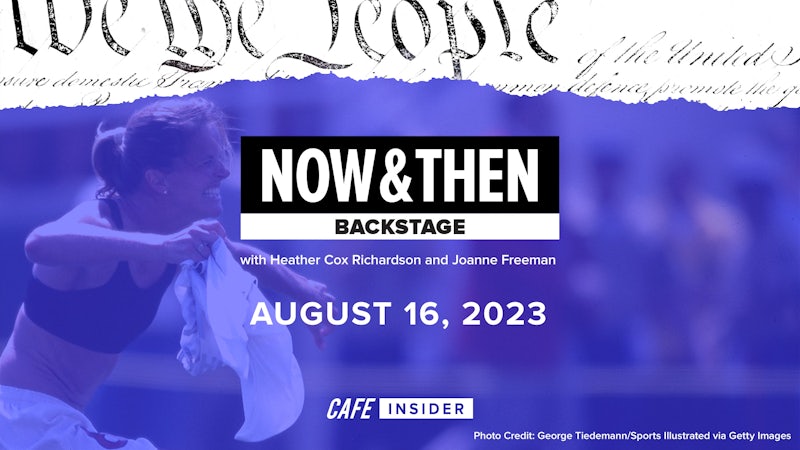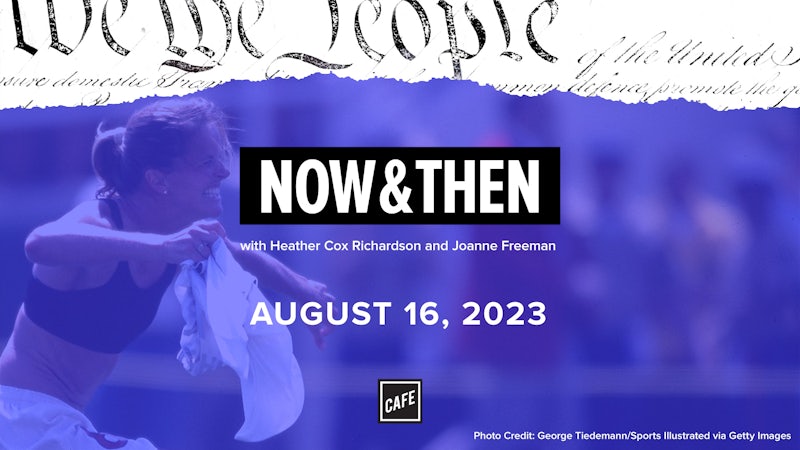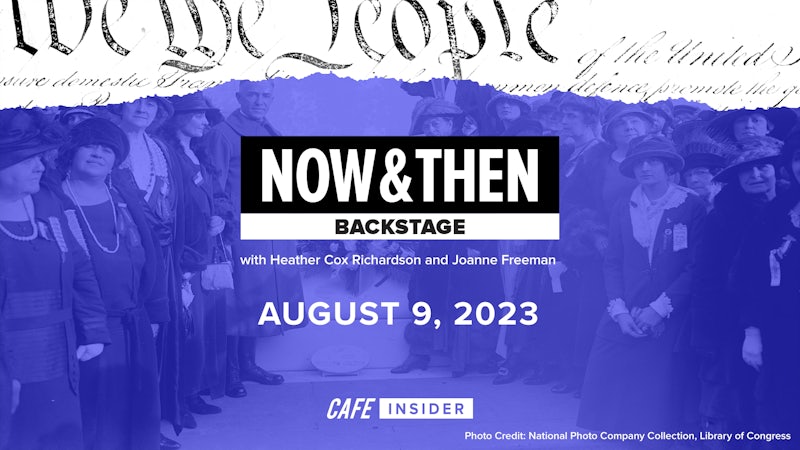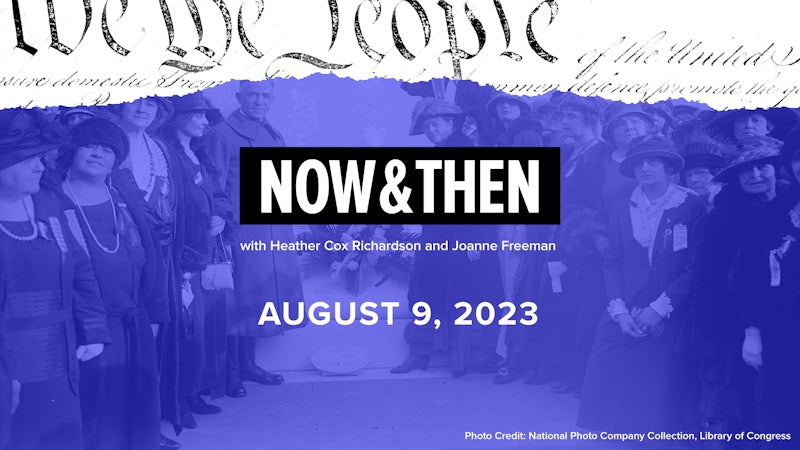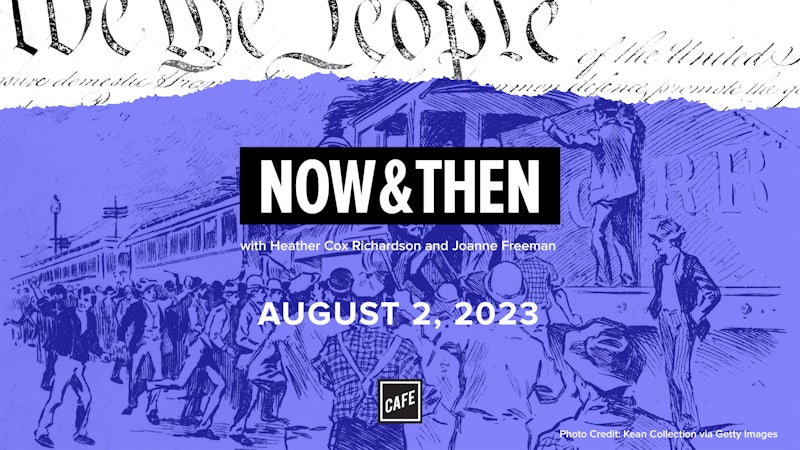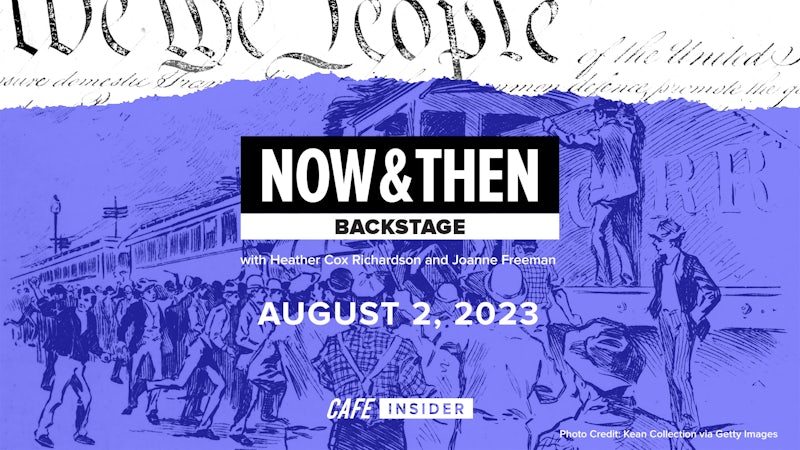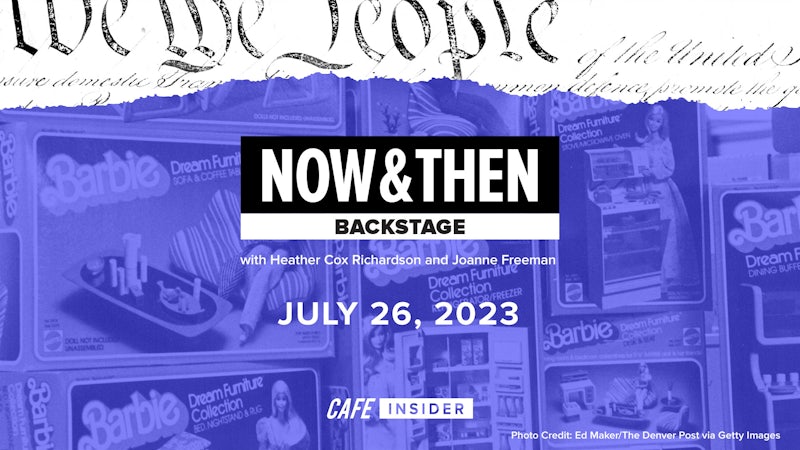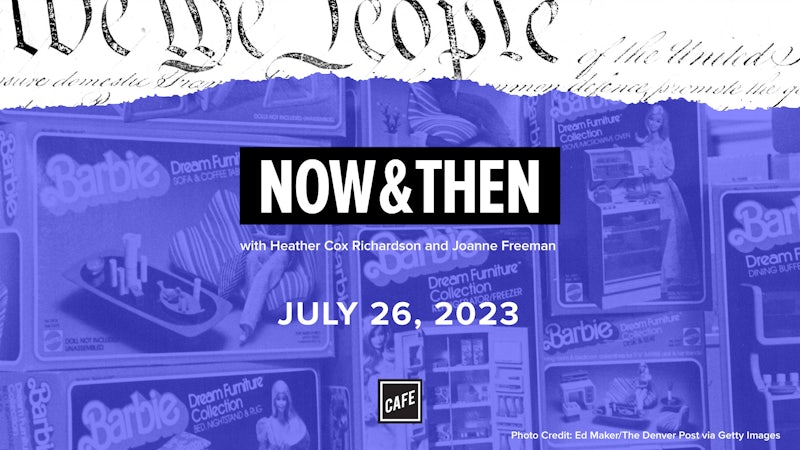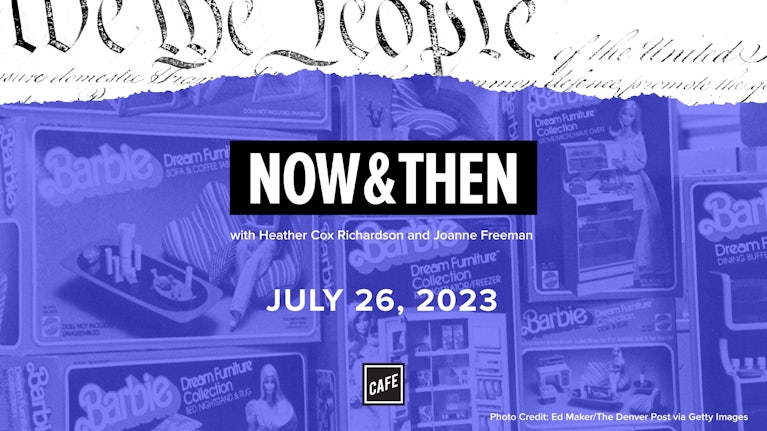Heather Cox Richardson:
From CAFE and the Vox Media Podcast Network, this is Now & Then. I’m Heather Cox Richardson.
Joanne Freeman:
And I’m Joanne Freeman. This is the final episode of our three-installment series, “Bans, Schools, & Power.”
Today, we’re going to look at how bullying and minority rule are so often central to American political battles, including the current debates over freedom of speech and public education. Now, we decided to talk about this today, in part, because we are seeing this bullying by minority numbers all over the place in American politics right now.
We’re seeing it at school board meetings when small groups of people, sometimes not even from the place where the school is in effect, are yelling about what they do or don’t want at these meetings and trying to drown debate out. We see it among small groups of individuals who are angry about masks and are pitching themselves in a semi-organized way to oppose masking or along similar lines, vaccines, people who are, again, not necessarily the majority.
And polling data suggests very often that along many of these lines, majority numbers are okay with masks and fine with vaccines. What we’re seeing is small groups of people who, in one way or another, are using their loudness, their anger, a bullying posture to make it look as though they have a majority, they have power, and to insist that they need to be listened to. So, what we want to talk about today is some examples of that in history and what that might offer us in the way of insight into what’s going on right now.
Heather Cox Richardson:
And one of the things people say when they talk about bullying and the actions that we’re seeing today is that that kind of behavior is a refuge when you know you don’t have the popular numbers, that you can turn political debate, you can turn popular debate by yelling a lot essentially, by making your view dominant and making it seem as if you have the numbers that you don’t, in fact. It’s a truism that you don’t have to be a bully if you’re in control.
Joanne Freeman:
And in democratic rule, any kind of government that is democratic, numbers matter. Numbers matter. So, on the one hand, if you are having free and fair elections, you are having elections that are putting things in power according to what the public wants. On the other hand, image can be power in a democracy where what matters is what people think the majority want.
And that’s some of what we’re seeing and talking about today is people who don’t have the majority, who know they do not have the small-d democratic support for what they want. But they also know, if they make it look like they’re loud and have big numbers, that they can potentially convince people that they’re big enough numbers, that they can really get their way and that can have an impact.
Heather Cox Richardson:
So, I saw a wonderful image of this the other day where somebody put this in a drawing, and had a whole bunch of little brains that were probably five different colors. There was a pink brain and a blue brain and a white brain and an orange brain. And they pointed out that in a normal political situation that most people divide into, let’s say, five different groups.
But that if suddenly the orange brain starts saying, “If you don’t think like I do, you’re bad,” that will shut up the other voices because they don’t want to be seen as bad. And pretty soon, everybody starts to think everybody’s an orange even though inside, they’re still all those different colors. So, the role of language and the role of posture matters a lot in terms of turning what people think is happening versus what’s really happening.
So, in order to talk about this, Joanne, I thought it would be useful for us to go find a historian who, I don’t know, maybe wrote a book about bullying or something. Do you think we could do that somewhere?
Joanne Freeman:
There might be someone out there who’s written about bullying and politics at an era.
Heather Cox Richardson:
I had to slip that one in there. Joanne is, in fact, our national expert on … I was just about to say our national expert on bullying, our national expert on bullying in history.
Joanne Freeman:
People don’t know what I look like. I’m like 5 feet tall and smiling all the time, so a national expert on bullying. A bully? Really, really not going to happen.
Heather Cox Richardson:
But in the early republic and in the lead up to the Civil War, because one of the things that your work does is it introduces into the way we understand politics, the sort of emotional aspect of that and how people garnered power. Political historians tend to look at votes, they tend to look at mass movements, but the element of garnering power has a lot to do with emotions and how you present yourself.
Joanne Freeman:
Absolutely. Generally speaking, not even just in the time period that I write about, but bullying could have a major, major positive impact if it’s done the right way. Because on the one hand, the person doing the bullying, potentially, can look like they’re powerful and brave and bold, and they can look as though they’re quite confident. As you just said, the posturing and the performance matters a lot.
It can inspire other people to follow along in the wave of emotion that that might cause. And a successful bully will cause other people to cower or to silence themselves or will intimidate other people, basically, into self-censorship because they’re afraid of that orange brain. They’re afraid that if they speak up or say something that’s going to resist the bully, that they themselves might be attacked, that they’re going to be humiliated, that all that they represent or stand for will be humiliated. And in many cases, it’s easier to just hold back and be silent and assume that the bully and their powerful minions are the ones who are in control.
Heather Cox Richardson:
So, what did that look like in the period leading up to the Civil War? I mean, literally, when you talk about somebody being a bully in a political sphere, in the 1850s for example or earlier if you’d like … I don’t really have anybody in mind here, Thomas Jefferson. I don’t really have anybody in mind here about who might have been a bully. I’m totally teasing you. But what did that look like in those days?
Joanne Freeman:
So, what I’ve written about more than anything else in the realm of bullying is Congress, and that was a deliberate ploy. As a matter of fact, they used the word bully. For example, Preston Brooks of South Carolina, who becomes so well known for caning abolitionist Senator Charles Sumner, he was called Bully Brooks because there were certain people who took that a stance. They were people who deliberately use threats and force and intimidation to make a point and to lead the way for people who agreed with them.
What that looked like, and as I just said a moment ago, it’s deliberate and organized. Was Southerners in Congress using threats, threatening violence, holding weapons, suggesting or threatening challenges to duels? Using physical threats or the threat of just open public humiliation and the knowledge that these Southerners probably were armed and willing to fight in a way that Northerners often weren’t, they use that to just cowl opposition, to encourage people to not speak up, particularly on the issue of slavery.
Heather Cox Richardson:
So, wait a minute, are you saying that it was Southerners who did this and not Northerners? Or did some Northerners do it as well?
Joanne Freeman:
Well, initially in Congress, it’s Southerners who are practicing this kind of behavior. And there’s a phrase at the time, people would refer to what they called the slave power. And on a not literal dimension, what they meant was that Southerners acted together to defend the institution of slavery. But in the national government, what that meant was that the South had outsized representation because of the Three-Fifths Compromise.
And because they were basically getting representation based on part of their enslaved population, there was a power, a slave power, in the national government with outsized power that used that kind of bullying behavior to steer national policy.
Heather Cox Richardson:
Does this start specific time or is this something that’s just a holdover from the early republic? Because in the early republic, you’ve also written about how they were having duels. That’s not quite the same thing?
Joanne Freeman:
No. So, I would definitely say violence is always there and dueling is there. And there are certainly people using threats of dishonor and a variety of other things to get their way politically. But we’re looking at in the 1830s, and ’40s and ’50s. And by that point, we have organized political parties. And also, increasing sectionalism is groups of people, so not individuals, but groups of people who together are acting to terrify opponents into silence.
There’s one member of Congress in the 1840s, I believe, who he’s overheard saying to a fellow Southerner that the key is to keep anyone who’s opposed to slavery afraid for their life. If we can do that, we’re in, we’re good. They’re not going to stand up against us. Or if they do, it will be very few of them. So, if we can create this bullying atmosphere, we can discourage opposition to the institution of slavery.
Heather Cox Richardson:
Why don’t the Northerners stand up to that?
Joanne Freeman:
Well, in part, that’s because in the South, generally speaking, it was more violent. It was a slave regime. Southerners and certainly southern members of Congress were used to having “mastery in every way possible through violence.” They weren’t normally armed. They were very willing to fight duels. Northerners, that behavior wasn’t smiled upon in the North.
And so, you very often have Northern politicians of various sorts who would be openly debating with each other what to do in a given situation because they would assume that if they respond in kind, which no one really wanted to do anyway, but if they were to somehow stand up and agree to fight a duel, their political career would be over, their reputation would be destroyed, they could never go home again. There are all kinds of statements like that among Northerners trying to figure out what to do in this kind of a regime, a political regime, in which they’re stuck.
When I write about it, I call it the Northern Congressman’s Dilemma. What do you do? Do you risk your life, put yourself in an unpleasant situation and potentially lose all of your sport back home? Do you not do that and also potentially lose all of your support back home for allowing the Southerners to tread all over you? So, it’s difficult but it’s a great example of the real power, that kind of bullying.
And the word bullying, I realized, is a little problematic because we associate with schools, in a sense that takes away some of the power of it as a really serious organized political maneuver. And also, it was a display of unity. So, if we have a bunch of people who are behaving that way and other people supporting them, it seems as though there’s a team of people playing by those rules, and that in and of itself, whether they’re the majority or the minority, they claim a kind of power.
And people at the time, who observed what was going on in Congress or who were in Congress, readily acknowledged that what you had in Congress were the Southerners who stuck together, defended slavery no matter what, defended the use of threats and violence to defend their regime. And basically, by acting loud, violent and organized in a unified manner, they had a lot of influence that they wouldn’t necessarily have had. John Quincy Adams, at one point, uses the great phrase that slaveholding congressmen have their power because they “march in solid phalanx.” They’re just a unit of angry, violent defense of slavery. And that gives them a kind of power that it’s very hard to resist.
Heather Cox Richardson:
It’s also important to remember that they actually are a significant minority. I mean, the people who are talking like this are not only a minority in the union; they’re also a minority in the American South. Those numbers don’t include any of the African-Americans in the South. They also are advancing policies that are not popular with the majority of poor white farmers as well.
So, they’re really, really a minority, but they managed to convince people they are a majority both, I suspect, by doing this, by being as violent as they are, but also by turning violent against anybody who tries to advance a different kind of way of looking at the world. So, we have talked here about Hinton Rowan Helper’s book. And they silenced that book or we haven’t talked too much about Uncle Tom’s Cabin but that’s another one, they did not let anybody else have access to any information that would challenge them.
Joanne Freeman:
The key to this, too, is with that kind of bullying, even if they didn’t persuade people that they were the majority in number, they had a great deal of power because of it. So, there are even people, Northerners in Congress and the lead up to the Civil War, who understood that the kind of people doing all of this performative bullying in Congress didn’t necessarily represent the majority of Southerners certainly, and they still were affected by it. But they also assumed that for that reason, maybe it didn’t have as much of a threat behind it other than immediate pain, violence and humiliation, as it suggested.
So, for example, there’s Henry Wilson of Massachusetts in the Senate. And he said that the slave power attempts to bully people into compliance. He called them, great phrase, “It was a tragic strut intended to startle and appall the timid, make the civility of the servile, still more abject, and so retain their grasp on power.” So, what’s striking about this is what they’re doing is partly to suggest that they have the power of numbers. Even among people who know they’re not in a majority, they still have an outsized degree of power.
And that becomes really complicated as you move up to the secession crisis, as you move up to the moment when the Southerners are beginning to discuss secession. Because in some ways, you could say, “Well, they’re performing that. They’re performing bullying, but are they really going to succeed? I mean, do they really have majority numbers to do that?”
Heather Cox Richardson:
And that’s really interesting because part of what you’re talking about is a form of terrorism in which they convince people it’s not worth stepping out of line because you’re going to get tarred and feathered. There’s a story of putting a bunch of guys on a raft and pushing them out into the middle of the rapids of a river to get rid of them.
People, especially ordinary people, don’t want to stick their necks out because a gang is going to come and hurt them, harass them, make their lives difficult, run them out of town. And so, even if they don’t speak for a majority, a few of them have enough power in local situations to convince a lot of people that it’s not worth sticking their necks out.
Joanne Freeman:
You can stand back and say, “Well, they don’t have the numbers to do this, and thus, in a sense, underestimate them.” But this brings us right to the crux of what we’re talking about today which is what happens when you’re an organized, loud, angry group of people who can act in that way to push things through although you don’t have the numbers. So, what happens? Let’s talk about what happens with the secession crisis and the actual process of secession.
Heather Cox Richardson:
Well, one of the things that I am fascinated by with the actual process of secession is that it begins because of South Carolina. South Carolina is the only state in the Union at the time that still chooses its presidential electors by its legislature. So, the legislature is actually in session and they produced electors, obviously not for Lincoln. And when Lincoln is elected, they are still all hanging out together and they say, “This is it, we need to secede from the Union.”
There is not a popular movement for that there is not “Let’s take a poll. Let’s have a vote. Let’s do all sorts of things that reflect the will of the majority.” They’re like, “No, we’re in charge and we’re going out.” The second wave of secession, when the Upper South goes out, they do that after Lincoln calls up troops after the firing on Fort Sumter.
So, they’re reacting to something that Lincoln has done. But that first set of Deep Southern states that goes, they don’t have popular votes, they don’t have all of the sorts of things that would reflect, “Hey, yeah, there’s really a majority that wants out.” Texas is one of the only states that is going to allow there to be a popular referendum on whether or not to secede. And they don’t even let all the counties vote. They don’t let the counties vote where they know there’s going to be a vote against it.
Otherwise, it’s secession conventions that are dominated by the slave power you’re talking about by the wealthy enslavers who decide on their own that their states are going to try and create their own new country based on human enslavement. And then of course, after the fighting starts, people have a lot of different reasons to be involved in that war. But the actual creation of a war comes really from this minority of white, wealthy, Southern enslavers.
Joanne Freeman:
Loud, organized, acting in unison, claiming to represent to have a real mandate for what they’re doing. I mean, doing all of the posturing that suggests in a democratic-minded populace that, yeah, they have power and they’re doing what people with power do.
Now, it’s important to note that all of that bullying for all of those years, one of the things that it does, is rouse organized resistance in the form of the Republican Party. They rise to power in the mid-1850s claiming in their campaign literature that they’re going to fight the slave power. So they literally are saying, “Yeah, these guys, these bullies on what they’re doing. We’re going to fight that. We’re going to stand up to them in a way that Northerners don’t normally do.”
Heather Cox Richardson:
Yes. And that’s really key because Lincoln who articulates that makes it a point always to say, “Hey, we’re the ones over here who believed in the Declaration of Independence. We’re the ones who are really defending America.” “You weenies over there,” and by the way, that’s me talking not Lincoln, “are the ones who are trying to destroy our traditions.”
And that switch in language, I think, is really important. He’s not in any rush to go to war. And he says this again and again. And I think this is important too when he was elected and he says to them in his first inaugural, “Slow down, slow down. Don’t do this in a hurry. You don’t want to do this and you need to take your time and think this over.” And that I think is also a key to this that when a minority is trying to take over a majority system through bullying, they want to move really quickly before people can slow down and think about it and figure out how to push back against them.
Joanne Freeman:
And emotion is their friend in that effort. You can push people to behave and move forward and grab at something and not think. If you can push them ahead with propaganda or getting emotions going or getting people rouse and getting them angry, that’s the sort of thing that can be really effective for a minority that’s grabbing for power.
What you see in Congress is Southern delegations, one after another, standing up and saying that their state has now seceded from the union and leaving the room. And you have rooms full of legislators who are just unbelieving about what they’re seeing happen. They’re watching the union dissolve. And it’s not as though all of the bullying hadn’t happened. It’s not as though there wasn’t talk of secession. It’s not as though there wasn’t all the posturing. But this group of people that is not the majority, they have pushed through this maneuver. And it’s a stunning thing to see. It’s a stunning thing to happen.
Heather Cox Richardson:
I guessed I’d never thought of that. I certainly know the farewell addresses, but to sit there and watch it dissolving. I mean, we’ve talked about how we reacted to January 6th. And to sit there and watch these people you’ve known and you’ve read their works, and you’ve argued with them, and you’ve been in those boarding houses with them and to watch them. And I think some of them were in tears, weren’t they? I mean, they were doing it because they wanted to, but they were quite upset about it.
Joanne Freeman:
They were because it was coming from their state that was telling them that this was what should be happening. Some of them were in tears. There are people in the galleries who were in tears. And there’s one particular day when three state delegations withdrew in one day. And supposedly, a Virginia Senator, James Mason, said out loud as he stared at the empty seats, pointed to them and said, “The Union is now dissolved. What a moment. What a striking thing. And it’s being carried out by this loud, organized, angry, minority group.”
Heather Cox Richardson:
That’s the piece that always just floors me when we talk about the coming of the Civil War because, of course, in retrospect, we know what that’s going to do. We know how many hundreds of, thousands of people it’s going to kill, how badly it’s going to devastate the country, how much it’s going to cost. And we also know who’s going to pay for it. And I don’t mean in money, I mean, in everything.
And it’s not going to be the guys who gave up and swung their swords and said, “We’re going to start a new country.” It’s going to be the people back home that are like, “Yeah, okay, I’ll go fight for South Carolina,” and they’re going to lose everything. And every time that I think about that moment … I mean, I just sort of feel like you could see those guys being like, “Yeah, I’m going to start my own country.”
And then you’d think those poor men back home who are going to be marching off to war for all the wrong reasons, and believing in these people, believing that they’re a majority, believing that they can actually pull it off, and knowing that they’re going to die, their kids are going to die.
Joanne Freeman:
But that’s an important point about these people marching off following the lead of this sword waving as, “Let’s make our own country,” is that part of what that kind of a minority does, of course, is wrapped themselves in the flag. Now, in this case, they have their own flag. But by that, I mean, they’re claiming that what they’re doing is the ultra-American thing to do. They represent America. They’re standing up for everything American. And the other side is un-American, but they themselves stand up for everything that’s true.
And so, these people marching off and losing everything, they’re partly following that message which is the message maybe coming from an aggressive minority but it’s a majority-sounding message.
Heather Cox Richardson:
Yeah. And you don’t want to be the one guy going, “Heck, no, I’m not going to be out there. You people are idiots.” Anyway, so from that which is such a dramatic moment when we get a minority really doing this extraordinary dramatic thing, it seemed like it would be instructive to compare it to a time when a minority tried to do the same thing and failed.
We were talking about this and we decided that we do not in America, at least to date, study as deeply as we should the importance of the rise of the right-wing in the 1930s, especially the country’s embrace of proto-Nazi groups or even Nazi groups. And their story is a lot like that of the people who took over the American south in the 1850s in some ways and not like it in others. And the places where those similarities are and differences are seem somewhat important.
So, it’s probably worth pointing out that the concept of fascism rises in the 1920s out of Italy and is really articulated by Benito Mussolini. And it is an attempt to try and move a modernized industrialized society forward by getting rid of the concept of democracy, getting rid of the idea that people should be able to make their own decisions that’s far too messy. In fact, he articulates the idea that some people, about 10% of the population, really have a much better sense of how to run society than the masses do.
And of that group, there’s one person really who should have control of the country. And they can meld that vast majority of people together through nationalism, through racism, through militarism. It’s a very 20th century kind of ideas.
So, one of the people that a lot of Americans have heard of even today is Father Coughlin, Father Charles Coughlin, who was a Canadian-born Catholic priest who is based out of Detroit in the 1920s, in the 1930s. And he’s going to become a major right-wing voice trying to present himself as the leader of a majority. So Coughlin, in the 1920s, begins to offer the first Catholic masses on the radio. And he broadcasts out of an ornate little sanctuary called the Shrine of the Little Flower.
And he peaked in popularity in the 1930s with about 30 million Americans listening to Father Coughlin’s radio show. And that was about three times larger than any other radio show in the world. It was biggest radio audience in the world. In 1939, he still was getting about 15 million listeners tuning in to at least part of his program, and only about four out of 10 of them were Catholics. About one out of every three of Coughlin’s listeners disapproved of what he said. But if you didn’t listen to him, 75% of people disapproved of what he said.
So, he had this enormous following except some of the people listening to him didn’t believe him and except the fact that nobody who wasn’t listening to him believed in him. And Coughlin is important for the rise of a similar kind of bullying personality, not least because he was that kind of man himself. He blustered and there’s a wonderful image of him yelling at the radio microphone.
But he initially began as a supporter of Franklin Delano Roosevelt. And by the middle of the 1930s, he had turned against him and was increasingly echoing the language of Nazis. He began to talk about Nazism as a reasonable response to an enemy and the enemy, in that case, was socialism.
And he associated Franklin Delano Roosevelt, a president who was trying to level the playing field between employers and workers and trying to redress some of the real excesses of 1920s’ capitalism, with the idea of socialism. And FDR was not a socialist by any stretch of the imagination, but that was certainly the way that business people portrayed him and the way that Coughlin came to portray him.
And Coughlin, essentially, signed on to Nazism because he believed that it represented somebody pushing back against that dangerous socialism that he saw. In 1938, he said.
Charles Coughlin (archival):
Nazism was conceived as a political defense mechanism against communism, and was ushered into existence as a result of communism. And communism itself was regarded by the rising generation of Germans as a product not of Russia, but of a group of Jews who dominated the destinies of Russia.
Did these Germans have facts as they said to substantiate this belief in the minds of a Nazi body? Official information emanating from Russia itself informed the world that communism, while barbarously opposed to every form of Christianity, made it a crime for any comrade to utter a single word of reproach against the Jews.
Heather Cox Richardson:
Coughlin is going to line up with the Nazis with the belief that they are defending Christianity against godless communism and Judaism. That idea of pushing back against, in this case, socialism and secularism lines up religious followers on the side of the Nazis in the 1930s. It’s kind of a hard thing, I think, to get your head around, but it does mean that people who followed Father Coughlin were much more amenable to the Nazis than they were just standing against them, which seems completely counterintuitive to me. But there it is.
Joanne Freeman:
Well, so it’s worth noting, in that case, though. So, that extreme statement about Nazism as a defense mechanism against communism in Russia and eventually the Jews, it’s worth noting that the New York radio station that normally carried Coughlin’s show wouldn’t broadcast his next radio message. And it said, “Your broadcast last Sunday was calculated to incite religious and racial strife in America. When this was called to your attention in advance of your broadcast, you agreed to delete those misrepresentations which undeniably had this effect. You did not do so.”
Joanne Freeman:
What’s interesting is you have that kind of a really strong, extreme statement. And it actually raised some resistance because it was so strong, because it was so aggressive, because it was so extreme.
Heather Cox Richardson:
Well, in that case, the federal government is holding the line on the kind of incitement that one can put in the public press. And it’s interesting I think after that, as you say, that the Nazi press insisted that, as it said, America is not allowed to hear the truth. And then goes on to say that these ideas of people like Father Coughlin are being suppressed and you know who they are thinking of as being the people who were doing the suppressing. That idea that free speech means that you are allowed to rile up this kind of hatred is instructive, I think.
It looks back to the 1850s and the idea that we’ve been talking about who gets access to what kind of information. But in this case, the idea that our First Amendment should protect your ability to make these extraordinary incendiary statements and if you are not permitted to do that, it is somehow an attack on you, not on the people that you’re attacking.
Joanne Freeman:
So, there’s that weird dynamic to it. And then there’s the other component of it which is because you have free speech and can make those kinds of statements, you risk rousing opposition to them which is going to be built into any kind of extreme bullying. And a similar thing takes place just briefly. A little bit after the peak of Father Coughlin, it begins roughly in the mid-1930s and that is the rise of the German-American Bund organization, which was the most influential of a number of pro-Nazi German groups in the United States in the 1930s.
Like Coughlin, they eventually are supporters of fascism. And they want to promote that in the United States. The leader of their group, Fritz Kuhn, does a number of things leading up to this massive rally that they have at Madison Square Garden. They create camps, training camps, summer camps for kids with Teutonic sounding names like Camp Siegfried and Camp Nordland. They publish copies of Mein Kampf, Hitler’s testament, which bund members are required to own a copy of. So they’re definitely very clear about what it is that they’re pushing towards, their kind of innocence pushing for a kind of, I suppose you could say, ethnostate.
By 1938, they appear to have some kind of a force or a power behind them. Their meetings are drawing several thousand visitors. And then almost exactly 83 years ago, on February 20th, 1939, they have this massive rally at Madison Square Garden. They call it a pro-American rally. And they choose the date to have it in conjunction with George Washington’s birthday. And at the front of the rally is a 30-foot tall banner of George Washington. And he is between flags with swastikas on them. So they’re making, again, a pretty strong statement about what they represent.
There were 20,000 people present at that rally which was full of weird moments. Like, at the beginning of it, they all said the American pledge and had their audience held up in a Nazi salute. There were people wearing Nazi armbands and had swastika pennants. People who were giving speeches during this rally would address the audience as my fellow Christian Americans or fellow white Americans and unparasitic sects.
It was very much, say, white supremacist is the great understatement. As one person said actually in addressing the group, “We are not preaching race hatred, but race recognition and protection of our own race.” So, that’s the very clear message that they’re sending, really aggressive. It became a major issue in New York City. Now, it also brought many, many, many people into the streets in protest. All around Madison Square Garden, it became a big issue.
Heather Cox Richardson:
What we’ve got here is, first of all, people like Father Coughlin opening up a religious channel into this idea of Nazism. It’s almost a paradoxical Christian channel into support for Nazism as opposed to socialism and Judaism. And now, you’ve got this idea of including people in this sort of patriotic Christian language.
And another piece of that was precisely what they had done in Europe to try and spread Nazism through the population which is to organize people into small groups opposing something at the local level. So, they would be street fighters, essentially. And they didn’t have a political sense yet, but they would be a small group of people who would attack somebody for, usually, labor organization or for being part of the wrong ethnic group or racial group.
And the idea was to get people moving as gangs and starting to create violence against others and bond themselves. And once you had that sort of a street movement, those people could be radicalized politically really easily. And that actually came close to giving us a coup in 1934 when Wall Street broker, a guy named Gerald MacGuire, had deliberately brought this form of street organization from Europe to America and tried to recruit retired US Marine Major General Smedley Butler to do a similar kind of coup against FDR to try and take over the presidency of the United States with a fascist, with somebody who would stand against what they considered socialism.
It failed because Smedley Butler refused to do it. And then instead of trying to insert Nazism into the system through a coup, they turned to the street-level organizations that you’re talking about here that is an attempt, again, to organize the American people to make them into a majority even though they know they’re not one.
Joanne Freeman:
So, in the case of the Bund, they have this rousing rally, 20,000 people packed into Madison Square Garden. But because of that rally, and it seems to be such a strong statement, and because the bund at that point is rising, it really rouses a lot of opposition. And in the case of the bund, it rouses all of these New Yorkers who are angry about the fact that there’s this Nazi rally going on in Midtown Manhattan. They are protesting the rally.
So, it rouses a degree of attention on the part, certainly, of New Yorkers and more broadly publicly, of opposition in a way that perhaps wouldn’t have been as focused and organized before. And eventually, Kuhn is charged with tax evasion. He becomes a target because of that rally and is sentenced to two-and-a-half to five years in jail for tax evasion. And as luck would have it or as not much luck would have it, when he gets out of jail, Germany has declared war on the United States.
So, by the time he gets out of jail, there’s no way for him to step forward and praise Hitler and sell copies of Mein Kampf and move along the lines he had been moving along before. He ends up being deported to war-ravaged West Germany and died pretty much a broken man in Munich in 1951. What’s interesting about that, in the context of what we’re talking about today, Heather, is just these bullies, these people who make these strong statements trying to look like a majority, intimidating people in the process, claiming lots of attention.
Joanne Freeman:
As you put it before, kind of waving their swords around, “Look at us. We have power. We can seize even more power. Follow us. Anyone who objects to us, you need to be swept aside.” But that the risk in doing that is getting a lot of attention rousing opposition to this kind of extreme effort and having a majority actually realize that they’re a majority and move against you.
Heather Cox Richardson:
And that is why I find that period so interesting and why the contrast with the 1850s is so extraordinary because in the 1850s, the leaders of the secession movement made everything happen really quickly. So that opposition really couldn’t form until it does during the war, of course. But in this case, because they couldn’t move fast, because they got slowed down, it gave people enough time to stop and say, “Wait a minute. That’s not the direction we want to go. This is not what we stand for.”
And that very slowness that you’re talking about, the fact they can’t move as quickly as they want, the fact that they get stopped by Smedley Butler, the fact that people show up to protest, that Madison Square Garden meeting is absolutely key. And every time I think of the Madison Square Garden rally which is still mind-blowing, and I think it’s interesting that it really is not something that we talk about a lot in our history in general and lots of people don’t know they were that kind of attention to Nazi propaganda in America in the 1930s, I think of the Unite the Right rally which happened in Charlottesville, Virginia in 2017.
The right groups that were rallying and trying to come together and declare that America was going to be a white supremacist nation and they were really representing the majority, there was a significant pushback at the time, of course, that took Heather Heyer’s life but that was the day or a couple of days later when the then President Donald Trump came out and said they were good people on both sides, that Joe Biden decided to throw his hat back in the presidential ring because he’s like, “No, no, no, no, no, this is not what our country is supposed to stand for.”
And for a lot of people, that Unite the Right rally was a real light bulb moment in the same way that the Madison Square Garden Nazi rally was. And I have to think that seeing George Washington in between two swastikas was dystopian for a lot of Americans.
Joanne Freeman:
What you’re suggesting here, I think, is important because what you’ve just said, basically, is that these kinds of bullying efforts, extreme bullying efforts, they’re slowed down. And the slowing down is important by opposition. And that opposition is largely the majority, the people with numbers, realizing they don’t like what’s happening and standing up to protest that they don’t like what’s happening, and to say, “No, actually, that doesn’t represent us.”
It’s kind of a Pollyannaish message but it’s an important one which is that in talking about bullying and minorities using violence and loudness, and anger and emotion, and unified action to try and seize power and suggest they have big numbers, and thus, that they deserve power in a democratic form of government, that the people with numbers, the actual majority can do something, can stand up. And that if they slow down the effort, if they stand up and say, “No, actually, that’s not who we are,” it can make a difference. It can make a big difference.
Heather Cox Richardson:
Buying time enables the majority to find its voice again, and to stand up and say, “This is not what we stand for.” It enables those people whose brains are not really orange, the people who make up the rest of the population to say, “No, no, no, no, no, that’s not who we’re going to be.”
And the comparison of the rise of the Nazis in the 1930s in America and the slave power in the 1850s is instructive, I think, both because in the 1850s, that group of people did manage to take over the political apparatus of their states, and they didn’t in the 1930s. And also, because they managed to move really quickly and they didn’t in the 1930s.
And those two things are important in terms of thinking about perhaps where things are going today. There were plenty of occasions when things seemed like they were moving very quickly, especially after January of 2017. And our system, our legal system, our protest system, the things that we have in place, our political system, managed to slow that change down.
And I think one of the reasons that you’re seeing attacks on some of the places where things get slowed down is because it does make it much harder for a minority, allowed bullying minority to take power, to seize power against the will of a majority.
Joanne Freeman:
That kind of bullying minority effort is fueled by speed, and emotion, and hate, and demand, and urgency. We see it all the time today with people who, in a variety of different contexts, are saying, “I don’t like what you’re doing and I want what I want and I want it now.” There’s a lot of that floating around in any number of different contexts right now.
That’s the way minorities grab that power and potentially can gain that kind of power. But if you aren’t necessarily swept up in what that looks like, in the appearance of it, in the performance of it, and actually pause to think about the fact that that’s a minority view, that realization and the way in which you put that into action can have an impact.
So in essence, I guess what we’re partly saying here is, in a democratic form of government, democracy can actually matter in a positive way. The people with the numbers actually do have power. The question is, as you just put it, do they find their voice? How do they find their voice? And what do they do with it?
Heather Cox Richardson:
Well, that ties back to the idea of banning books and the idea of determining what can be talked about in schools and elsewhere is what kind of access you have to information, who gets to tell you what you get to think about, and how you radicalize a population to embrace any kind of minority movement by getting them angry over things like a book or getting them angry over the concept of some theory in a school that they don’t want.
It doesn’t have to be real; it just has to get people angry enough that they are willing to invest their emotions in it. And then from there, it’s easier to radicalize them.
Joanne Freeman:
Absolutely. And all of those efforts, the book banning, the public school attacking, those are about defining who is inside and who is outside of an American we. Much of what’s going on is people who are trying to assert who counts and who is in and, thus, who is in the majority and who is in the minority, that’s ultimately what this game is about is who counts? Who’s in? What kind of people actually matter in the United States of America? What kind of voice can they get? Do they deserve to have a voice? Of course, they do. And they deserve to have the same freedoms that people on the other side are demanding, and in some cases, denying on the other side.
So, what we’re talking about in this series of programs, really, is a variety of different ways in which people who don’t have the benefit of numbers are trying to persuade, compel, mislead, or force people into an understanding or an assumption about the way that the United States and its institutions exist, and are functioning, and should exist, and should function. And in doing so, grabbing power, although they don’t have the power of numbers. That’s what all of this represents.
And it’s a reminder of, we started out by talking about this, how important education is in a democratic form of government. Because unless you understand how democracy works and how it’s supposed to work, you might not recognize the fact that this effort is doing precisely what it’s trying to do. And you might not realize the ways in which access to information and knowledge about the functioning of government and its shape and reach, and what representation means, and what free and fair elections mean, education is part of how we keep that alive.
And part of the struggle we’re seeing right now is an attempt to push that kind of knowledge into the background. And that matters. Push that kind of knowledge into the background. And that matters.












